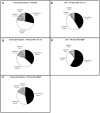Environmental exposure of the mouse germ line: DNA adducts in spermatozoa and formation of de novo mutations during spermatogenesis
- PMID: 20596530
- PMCID: PMC2893163
- DOI: 10.1371/journal.pone.0011349
Environmental exposure of the mouse germ line: DNA adducts in spermatozoa and formation of de novo mutations during spermatogenesis
Abstract
Background: Spermatozoal DNA damage is associated with poor sperm quality, disturbed embryonic development and early embryonic loss, and some genetic diseases originate from paternal de novo mutations. We previously reported poor repair of bulky DNA-lesions in rodent testicular cells.
Methodology/principal findings: We studied the fate of DNA lesions in the male germ line. B[a]PDE-N(2)-dG adducts were determined by liquid chromatography-tandem mass spectrometry, and de novo mutations were measured in the cII-transgene, in Big Blue mice exposed to benzo[a]pyrene (B[a]P; 3 x 50 mg/kg bw, i.p.). Spermatozoa were harvested at various time-points following exposure, to study the consequences of exposure during the different stages of spermatogenesis. B[a]PDE-N(2)-dG adducts induced by exposure of spermatocytes or later stages of spermatogenesis persisted at high levels in the resulting spermatozoa. Spermatozoa originating from exposed spermatogonia did not contain DNA adducts; however de novo mutations had been induced (p = 0.029), specifically GC-TA transversions, characteristic of B[a]P mutagenesis. Moreover, a specific spectrum of spontaneous mutations was consistently observed in spermatozoa.
Conclusions/significance: A temporal pattern of genotoxic consequences following exposure was identified, with an initial increase in DNA adduct levels in spermatozoa, believed to influence fertility, followed by induction of germ line de novo mutations with possible consequences for the offspring.
Conflict of interest statement
Figures





References
-
- Fraga CG, Motchnik PA, Wyrobek AJ, Rempel DM, Ames BN. Smoking and low antioxidant levels increase oxidative damage to sperm DNA. Mutat Res. 1996;351:199–203. - PubMed
-
- Ni ZY, Liu YQ, Shen HM, Chia SE, Ong CN. Does the increase of 8-hydroxydeoxyguanosine lead to poor sperm quality? Mutat Res. 1997;381:77–82. - PubMed
Publication types
MeSH terms
Substances
LinkOut - more resources
Full Text Sources
Miscellaneous

